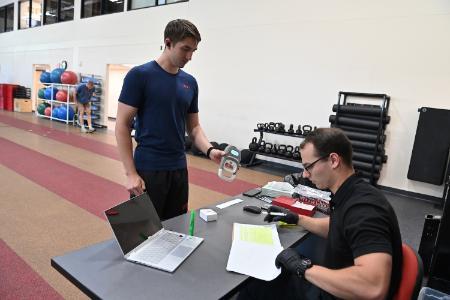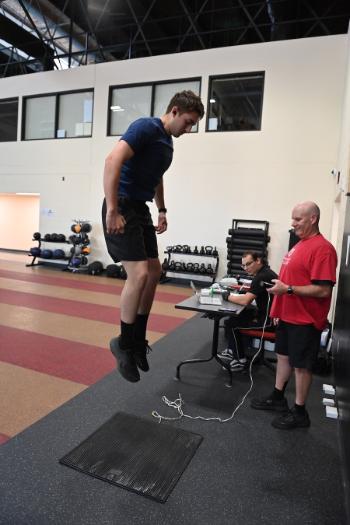Can Music Improve Athletic Performance?

Aidan Carman ’27 shares his grip test results with Colton Shirk ’27. –VMI Photo by Kelly Nye.

LEXINGTON, Va. June 26, 2025 — If music can charm a savage beast, could it also bring out the beast in an athlete? Music is known to help lower anxiety and stress, slow the heart rate, and create a calming effect, but can certain music enhance an athlete’s performance? Colton Shirk ’27, a biology major minoring in exercise science at Virginia Military Institute, sought to answer the question for his Summer Undergraduate Research Institute (SURI) project, “Effects of Music Genre on Vertical Jump Power and Hand Grip Strength in Resistance Trained College Students.”
Shirk proposed two hypotheses. The first: More aggressive, angry, arousing music genres such as heavy metal, will produce a greater ergogenic effect than sedating, soft, calming genres such as jazz, across songs with similar tempo in strength and power tests. The second: This increase in strength and power is mediated by an increase in salivary A-Amylase enzyme, signaling an increase in epinephrine within the body.
A-Amylase is an enzyme that breaks down starch into simpler sugars, facilitating digestion. Epinephrine, also known as adrenaline, is produced naturally by the adrenal glands. It increases heart rate, and is a key part of the body’s emergency fight-or-flight response to danger.
To test his hypotheses, Shirk recruited volunteers from the VMI Corps of Cadets between the ages of 18 and 25, who have had at least three consecutive years of weightlifting training, and with no reported severe orthopedic or muscular injury within the last year to be his test subjects.
According to Shirk, subjects were tested on five separate dates. They were instructed to abstain from ingesting alcohol 12 hours prior to testing days; from caffeine and other stimulants six hours prior to testing; from eating large meals, sugary or acidic food and drink, and ingesting nicotine for 90 minutes prior to testing; and from any vigorous lower body exercise 48 hours prior to testing.
“Upon arrival to the lab, subjects’ weights were recorded, and each rinsed out their mouths thoroughly with water. Each test began with the subject completing a standard lower body warmup routine consisting of a hamstring stretch, quadriceps stretch, and two minutes jumping rope. They were exposed to one of five musical conditions—no music, heavy metal, rock, pop, or jazz—then performed vertical jump tests to assess lower body power, an isometric hand grip dynamometer test to assess upper body strength, then provided saliva samples to assess A-Amylase enzyme concentrations. They then rested for three minutes. They repeated the jump test, grip test, rest cycle two times. When the subjects completed testing for each condition, they took a survey to rate their familiarity with each of the four songs,” he reported.
Shirk’s faculty mentor, Col. Mike Krackow, professor in the Department of Human Performance and Wellness, shared that the research is very important. “Coaches and athletes are always looking for ways to improve their performance. If this study can show that specific music genres can improve strength and power, it can become a valuable resource as part of their training. Future cadets or other researchers can use the results of Shirk’s work and expand on it. With expanding technologies, athletes and coaches can customize music playlists specific to what promotes the greatest performance for that individual. This work is just the beginning of something that can become much larger in terms of athletic performance.”
Following data analysis, Shirk found that his results were inconclusive. He plans to increase his sample size when he continues the research during the upcoming fall semester.
Marianne Hause
Communications & Marketing
VIRGINIA MILITARY INSTITUTE
.svg)
.png)
